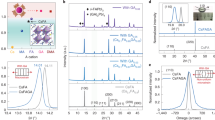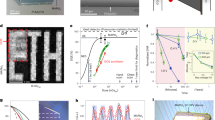Abstract
The monolithic integration of new optoelectronic materials with well-established inexpensive silicon circuitry is leading to new applications, functionality and simple readouts. Here, we show that single crystals of hybrid perovskites can be integrated onto virtually any substrates, including silicon wafers, through facile, low-temperature, solution-processed molecular bonding. The brominated (3-aminopropyl)triethoxysilane molecule binds the native oxide of silicon and participates in the perovskite crystal with its ammonium bromide group, yielding a solid mechanical and electrical connection. The dipole of the bonding molecule reduces device noise while retaining signal intensity. The reduction of dark current enables the detectors to be operated at increased bias, resulting in a sensitivity of 2.1 × 104 µC Gyair−1 cm−2 under 8 keV X-ray radiation, which is over a thousand times higher than the sensitivity of amorphous selenium detectors. X-ray imaging with both perovskite pixel detectors and linear array detectors reduces the total dose by 15–120-fold compared with state-of-the-art X-ray imaging systems.
This is a preview of subscription content, access via your institution
Access options
Access Nature and 54 other Nature Portfolio journals
Get Nature+, our best-value online-access subscription
$29.99 / 30 days
cancel any time
Subscribe to this journal
Receive 12 print issues and online access
$209.00 per year
only $17.42 per issue
Buy this article
- Purchase on Springer Link
- Instant access to full article PDF
Prices may be subject to local taxes which are calculated during checkout




Similar content being viewed by others
References
Barber, H. B. et al. Semiconductor pixel detectors for gamma-ray imaging in nuclear medicine. Nucl. Instrum. Methods Phys. Res. A 395, 421–428 (1997).
Kasap, S. et al. Amorphous and polycrystalline photoconductors for direct conversion flat panel X-ray image sensors. Sensors 11, 5112–5157 (2011).
Parker, S. I., Kenney, C. J. & Segal, J. 3D—A proposed new architecture for solid-state radiation detectors. Nucl. Instrum. Methods Phys. Res. A 395, 328–343 (1997).
Luke, P. N., Rossington, C. S. & Wesela, M. F. Low energy X-ray response of Ge detectors with amorphous Ge entrance contacts. IEEE Trans. Nucl. Sci. 41, 1074–1079 (1994).
Szeles, C. CdZnTe and CdTe materials for X-ray and gamma ray radiation detector applications. Phys. Status Solidi B 241, 783–790 (2004).
Jeong, M., Jo, W. J., Kim, H. S. & Ha, J. H. Radiation hardness characteristics of Si-PIN radiation detectors. Nucl. Instrum. Methods Phys. Res. A 784, 119–123 (2015).
Stoumpos, C. C. et al. Crystal growth of the perovskite semiconductor CsPbBr3: a new material for high-energy radiation detection. Cryst. Growth Des. 13, 2722–2727 (2013).
Zhao, W. & Rowlands, J. A. X-ray imaging using amorphous selenium: feasibility of a flat panel self-scanned detector for digital radiology. Med. Phys. 22, 1595–1604 (1995).
Dong, Q. et al. Electron-hole diffusion lengths >175 μm in solution-grown CH3NH3PbI3 single crystals. Science 347, 967–970 (2015).
Hu, M. et al. Distinct exciton dissociation behavior of organolead trihalide perovskite and excitonic semiconductors studied in the same system. Small 11, 2164–2169 (2015).
Huang, J., Shao, Y. & Dong, Q. Organometal trihalide perovskite single crystals: a next wave of materials for 25% efficiency photovoltaics and applications beyond? J. Phys. Chem. Lett. 6, 3218–3227 (2015).
Jeon, N. J. et al. Compositional engineering of perovskite materials for high-performance solar cells. Nature 517, 476–480 (2015).
Lin, Q. et al. Electro-optics of perovskite solar cells. Nat. Photon. 9, 106–112 (2014).
Liu, M., Johnston, M. B. & Snaith, H. J. Efficient planar heterojunction perovskite solar cells by vapour deposition. Nature 501, 395–398 (2013).
Saidaminov, M. I. et al. High-quality bulk hybrid perovskite single crystals within minutes by inverse temperature crystallization. Nat. Commun. 6, 7586 (2015).
Shi, D. et al. Low trap-state density and long carrier diffusion in organolead trihalide perovskite single crystals. Science 347, 519–522 (2015).
Yang, Y. et al. Low surface recombination velocity in solution-grown CH3NH3PbBr3 perovskite single crystal. Nat. Commun. 6, 7961 (2015).
Zhou, H. et al. Interface engineering of highly efficient perovskite solar cells. Science 345, 542–546 (2014).
Fang, Y. et al. Highly narrowband perovskite single-crystal photodetectors enabled by surface-charge recombination. Nat. Photon. 9, 679–686 (2015).
Chen, Q. et al. Under the spotlight: the organic–inorganic hybrid halide perovskite for optoelectronic applications. Nano Today 10, 355–396 (2015).
Wei, H. et al. Sensitive X-ray detectors made of methylammonium lead tribromide perovskite single crystals. Nat. Photon. 10, 333–339 (2016).
Yakunin, S. et al. Detection of X-ray photons by solution-processed lead halide perovskites. Nat. Photon. 9, 444–449 (2015).
Yakunin, S. et al. Detection of gamma photons using solution-grown single crystals of hybrid lead halide perovskites. Nat. Photon. 10, 585–589 (2016).
Wang, G. et al. Wafer-scale growth of large arrays of perovskite microplate crystals for functional electronics and optoelectronics. Sci. Adv. 1, e1500613 (2015).
Dou, L. et al. Atomically thin two-dimensional organic–inorganic hybrid perovskites. Science 349, 1518–1521 (2015).
Miyazaki, N., Kuroda, Y. & Sakaguchi, M. Dislocation density analyses of GaAs bulk single crystal during growth process (effects of crystal anisotropy). J. Cryst. Growth 218, 221–231 (2000).
Moram, M. A. et al. Young's modulus, Poisson's ratio, and residual stress and strain in (111)-oriented scandium nitride thin films on silicon. J. Appl. Phys. 100, 023514 (2006).
Wang, J., Huang, Q.-A. & Yu, H. Size and temperature dependence of Young's modulus of a silicon nano-plate. J. Phys. D 41, 165406 (2008).
Hopcroft, M. A., Nix, W. D. & Kenny, T. W. What is the Young's modulus of silicon? J. Microelectromech. Syst. 19, 229–238 (2010).
Lim, P. H., Park, S., Ishikawa, Y. & Wada, K. Enhanced direct bandgap emission in germanium by micromechanical strain engineering. Opt. Express 17, 16358–16365 (2009).
Wright, A. F. Elastic properties of zinc-blende and wurtzite AlN, GaN, and InN. J. Appl. Phys. 82, 2833–2839 (1997).
Ning, Z. et al. Quantum-dot-in-perovskite solids. Nature 523, 324–328 (2015).
Androulakis, J. et al. Dimensional reduction: a design tool for new radiation detection materials. Adv. Mater. 23, 4163–4167 (2011).
Hecht, K. Zum Mechanismus des lichtelektrischen Primärstromes in isolierenden Kristallen. Z. Phys. 77, 235–245 (1932).
Yin, W.-J., Shi, T. & Yan, Y. Unusual defect physics in CH3NH3PbI3 perovskite solar cell absorber. Appl. Phys. Lett. 104, 063903 (2014).
Kasap, S. O. X-ray sensitivity of photoconductors: application to stabilized a-Se. J. Phys. D 33, 2853–2865 (2000).
Currie, L. A. Limits for qualitative detection and quantitative determination. application to radiochemistry. Anal. Chem. 40, 586–593 (1968).
Büchele, P. et al. X-ray imaging with scintillator-sensitized hybrid organic photodetectors. Nat. Photon. 9, 843–848 (2015).
Akinlade, B. I., Farai, I. P., Okunade, A. A. Survey of dose area product received by patients undergoing common radiological examinations in four centers in Nigeria. J. Appl. Clin. Med. Phys. 13, 188–196 (2012).
Kirac, S. F. E. (ed.) Advances in the Diagnosis of Coronary Atherosclerosis (InTech, 2011).
Davies, A. G. et al. Do flat detector cardiac X-ray systems convey advantages over image-intensifier-based systems? Study comparing X-ray dose and image quality. Eur. Radiol. 17, 1787–1794 (2007).
Viggiano, A. et al. Exposure reduction by optimization of the imaging toolchain in pulmonary vein isolation. Eur. Heart J. 34(Suppl 1), P2344 (2013).
Ector, J. et al. Obesity is a major determinant of radiation dose in patients undergoing pulmonary vein isolation for atrial fibrillation. J. Am. Coll. Cardiol. 50, 234–242 (2007).
Nof, E. et al. Reducing radiation exposure in the electrophysiology laboratory: it is more than just fluoroscopy times! Pacing. Clin. Electrophysiol. 38, 136–145 (2015).
Davies, A. G. et al. X-ray dose reduction in fluoroscopically guided electrophysiology procedures. Pacing. Clin. Electrophysiol. 29, 262–271 (2006).
Pantos, I., Patatoukas, G., Katritsis, D. G. & Efstathopoulos, E. Patient radiation doses in interventional cardiology procedures. Curr. Cardiol. Rev. 5, 1–11 (2009).
Acknowledgements
This X-ray detector development and characterization work was financially supported by the Defense Threat Reduction Agency under award no. HDTRA1-14-1-0030. The KPFM study was supported financially by the National Science Foundation under awards DMR-1505535 and DMR-1420645. The authors thank S. Banerjee and D. Haden for discussions regarding X-ray dose rate calibration, and S. Valloppilly for his assistance in using the X-ray source in the XRD system (Rigaku Multiflex) for X-ray imaging.
Author information
Authors and Affiliations
Contributions
J.H. conceived and supervised the project. W.W. synthesized materials and fabricated the devices. Y.Z. and W.W. conducted the X-ray imaging measurements. H.W. measured the photodetector performance. Q.X. and L.C. measured the device performance under 50 keV X-ray radiation. Y.F. performed the photoluminescence lifetime measurement. T.L. and A.G. performed the KPFM measurement. Y.D. conducted SEM and XRD experiments. Q.W. carried out the TEM measurement. All authors analysed the data. J.H. wrote the manuscript and all authors reviewed the manuscript.
Corresponding author
Ethics declarations
Competing interests
The authors declare no competing financial interests.
Supplementary information
Supplementary information
Supplementary information (PDF 764 kb)
Rights and permissions
About this article
Cite this article
Wei, W., Zhang, Y., Xu, Q. et al. Monolithic integration of hybrid perovskite single crystals with heterogenous substrate for highly sensitive X-ray imaging. Nature Photon 11, 315–321 (2017). https://doi.org/10.1038/nphoton.2017.43
Received:
Accepted:
Published:
Issue Date:
DOI: https://doi.org/10.1038/nphoton.2017.43
This article is cited by
-
Reconfigurable perovskite X-ray detector for intelligent imaging
Nature Communications (2024)
-
A detachable interface for stable low-voltage stretchable transistor arrays and high-resolution X-ray imaging
Nature Communications (2024)
-
Cation-π interactions enabled water-stable perovskite X-ray flat mini-panel imager
Nature Communications (2024)
-
Heavy-to-light electron transition enabling real-time spectra detection of charged particles by a biocompatible semiconductor
Nature Communications (2024)
-
Real-time single-proton counting with transmissive perovskite nanocrystal scintillators
Nature Materials (2024)



